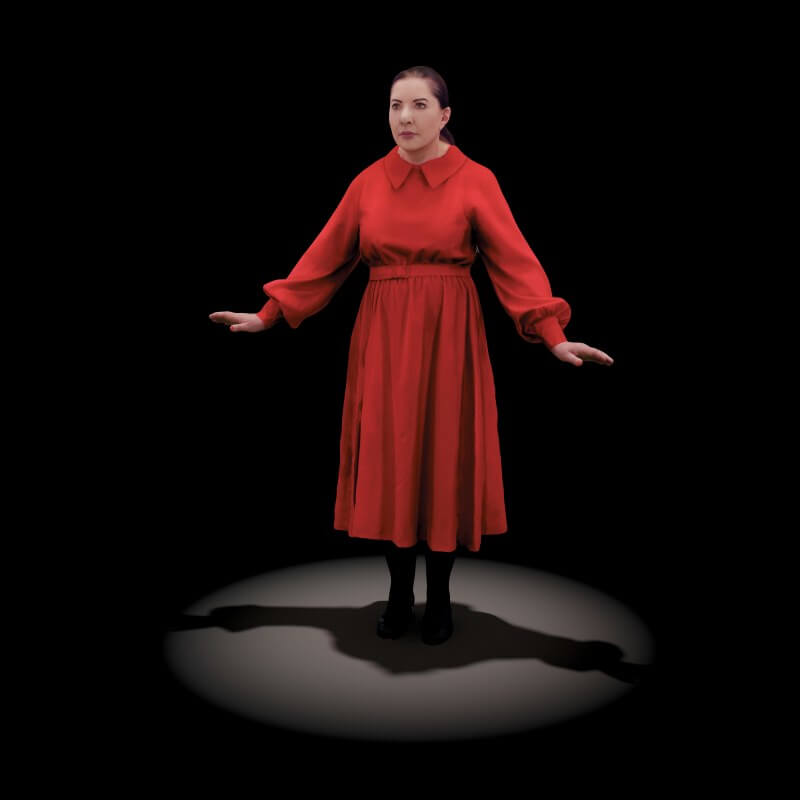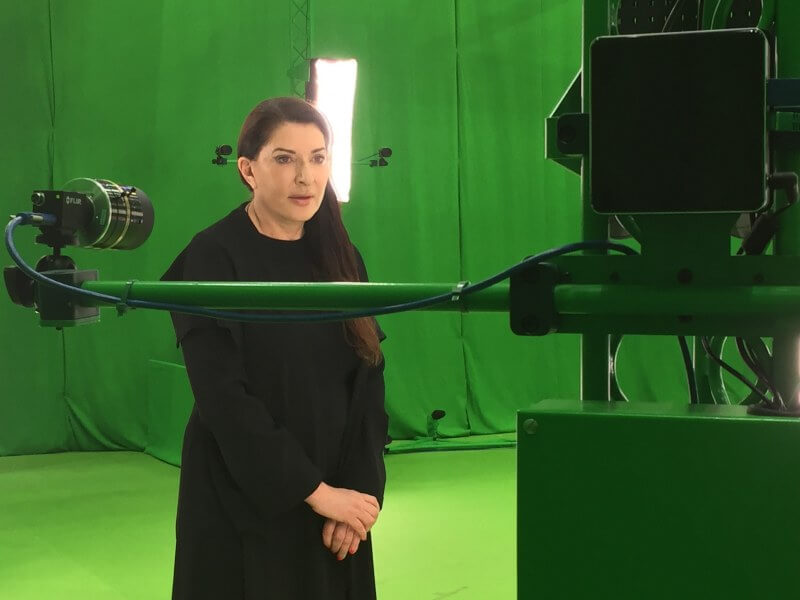Text by Agata Kik

With the changing nature of curating and the rapid development of contemporary digital technology, the idea of presence in the curatorial field shifts its concerns from material objects in a static display to embodied subjects who physically participate. Most recently, when performative art practices do not solely belong to the physical realm occupied by the artist’s body, it is their being in virtuality that the curator has to deal with. Moreover, the idea of presence in the expanded curatorial field increasingly more often refers to material absence instead of physically-constituted appearances.
In the context of technological progress, the presence of the artist, the curator and the viewer does not only belong to the ‘here and now’, but simultaneously belongs to there and possibly even then. To trace the idea of pluralized presence in contemporary art and curating practice, I suggest looking at the most recent performance works by Marina Abramovic, the internationally acclaimed artist who has pioneered performance art since the beginning of her career during the early 1970s in Belgrade.
In 2010, during her durational performance titled The Artist Is Present at the Museum of Modern Art in New York, the close physical proximity to the artist’s body was key. Performing every day for three months, the artist spent more than 700 hours silently sitting on a chair faced by individual visitors, one at a time, who queued in gigantic lines in front of the museum’s gate, to get a chance to exchange the artist’s gaze. Then in 2014, the artist’s durational performance titled 512 Hours, uniquely done for the Serpentine Galleries in London, was again based on close bodily proximity.
Contrastingly, this time the performance involved free movement and active physical participation of both the audience and the artist, who silently wandered around the gallery rooms, sat on chairs, lied on beds, with ears and eyes covered, as a form of guidance towards the inner self. In March 2019, Marina Abramovic returned to London to the Serpentine Gallery and presented her latest performance, The Life, produced in collaboration with augmented reality studio Tin Drum. This was the world’s first performance to be executed in Mixed Reality on such a large scale.
For The Life, the artist was not present there to be greeted at the gallery, but this time was replaced by her silent, slightly oversized hologram body, repeatedly performing the 19 minutes-long piece. During the production process, what happened there and then could have been experienced in a continuum always belonging to the present moment, shared with other viewers and in contrast to a digital image on the screen, it felt as always happening now and here.
To experience this mixed reality performance, one had to move slowly in the queue within the white walls of the gallery while supervised by white-clothed gallery assistants in aprons, who continuously asked to keep quiet for the whole duration of the time spent in this lab-like environment, to be finally given a hefty headset. This wearable mixed-reality device made the absent feel as fully present.
Led by the gallery assistant, holding my cold hand, I finally joined a circle made up of other viewers staring at Marina Abramovic, whose projected body came into existence straight after I had put on the cosmic headset and turned my head to face the centre of the designated stage. Here and now, she was, in the middle of the gathered group of speechless visitors. Folding temporalities and collapsing geographical boundaries, thanks to this extremely advanced technological set-up, the artist could preserve the past into infinity, or even reverse the time itself, something that scientists have just achieved using quantum mechanics, enabling the past to be lived as the present moment, recurring as the current.
This 4D virtual performance, viewed together with other members of the public, who corporeally coexisted with the virtual body of the artist, blurred the very fine line between the material real and the projected virtuality, highlighting the fact that they both belong to the very same moment of the representational world.

The body is the medium of one’s presence. Marina Abramovic has claimed that her body is the medium of her artistic practice, while performance art is all about energy. The body in performance art is only a medium, which is there to communicate the non-representational. This energy and all these vibratory intensities pass through and alter both the living and the inanimate.
In The Life, the artist’s presence was felt through visual contact with holographic light, whose energy circulated among all those gathered wearing the electronic headset. The energy that performance art is grounded in depends on the way in which the public relates not only to the artist but also to each other.
These relationship dynamics in Marina Abramovic’s recent performance pieces were not completely based on corporeality, as participation in them was not about contact with flesh but rather acknowledging the other’s existence through mental consciousness of their physicality. Thus, the experience of presence can be contributed to the other’s mind rather than one’s body. One can define presence as the experience of the unmediated, the essence that the image tries to convey.
Having said that, what does occur when mediation is mediated itself? Rather than the artist’s body to be experienced as an image mediating her presence, in the context of Mixed Reality, it is the virtual image of the artist that mediates her embodiment. It directly conveys her energetic self, transgressing the necessity of the physical signifier.
My body, augmented by the technological device with the electronic equipment becoming an intrinsic part of my perceptive self is a situation of our contemporary cyborg spectatorship, an increasingly common situation in the contemporary art world, where technology enables posthuman aesthetic experience, evading the anthropocentric reductivity, while implying increased dependence on technology in experiencing the surrounding environment.
Within their augmented reality in my augmented physicality, not only did temporal and spatial boundaries get blurred, but the distinction between the physical and the immaterial also started to fade away. Man and technology become a jointly-acting mechanism. The potential becomes the actual, while the reality is never full but always open to evermore novel experiences of parallel realms and of coinciding timescales.
In conclusion, what do we learn from the fact that the old divine presence can now be replaced by a mere technological trick? Does technology have the potential to return the aura that Walter Benjamin claimed to be lost with the increased physical reproductiveness, which seems to be especially missed in the contemporary day, of the increased pressure on the artist’s subject to be available there to be directly experienced by the audience?
At the moment, when technology is the gate to contemporary spirituality, while the artist does not need their physical body for their energy to be physically experienced by the public, there lies the potential for a future of collectivity and collaboration in the curatorial field. The subject’s presence as a holographic image makes one realise that we exist among man-made and technologically constructed, but perhaps also natural phenomena, which cannot always be perceived without technological equipment that might still be waiting to be invented.
It is not the fact that one could confuse a hologram with a fleshly body that resulted in the feeling of presence in Marina Abramovic’s latest performance at the Serpentine Gallery, but rather the fact that energy constantly circulates and does not necessarily have to materialise to be felt. Work of performance art is about energy, and thanks to technology, through which one can transcend the physical body, there lies an increased potential for affective sharing not necessarily derived from the essence of forms but rather generated by electrically-powered digital devices as a way of establishing bonds between organic elements of the material world.
The eighteenth-century German physician Franz Anton Mesmer already advocated animal magnetism, the force generated by lifeforms that flows between all inanimate and animate things. In the present day, though, the energy we experience does not even have to belong to the natural material world but can be carried through digitally coordinated electromagnetic waves.
Marina Abramovic achieves through her performances by bringing attention back to the importance of contact between human beings. In contrast, in her latest performance, The Life, she highlights the fact that technology, when rightly used, helps us bond at a distance while reinventing our idea of what it means to be present. I, thus, suggest an increased attention to the fluidity between bodily and digital proximity and the flux of affects, which will improve our way towards future being in the world and togetherness in the expanded curatorial field.






